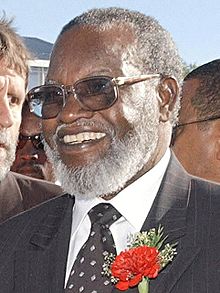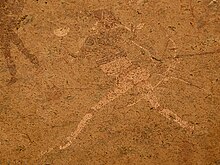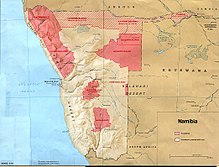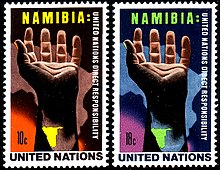History of Namibia
The history of Namibia encompasses the historical developments on the territory of the Republic of Namibia from prehistory and early history to after the independence of the state . The German colonial era, the League of Nations mandate exercised by South African administrative authorities and the independence efforts in the last third of the 20th century through political reform efforts by the multiethnic civilian population and in the Namibian struggle for independence represent essential periods of modernity .
Prehistory and early history
Finds a living years ago around 12 to 14 million apes ( Otavipithecus nambiensis ) in the Otavibergen have Namibia as one of the oldest settlements of early ancestors of the human race.
Fragments of stone slabs of the Apollo 11 cave with depictions of humans and animals found in the south of the country are estimated at 27,000 years before Christ. It is also assumed that some of the rock carvings on the Brandberg , in the Erongo Mountains and in the Spitzkoppe area are around 7,000 years old.
Until the European settlement
Until the first discovery by the Europeans, the country was very thinly inhabited by the partially nomadic peoples of the Damara and San . It is believed that the San are descendants of the original population of southern Africa.
Discovery by the Europeans
In 1486, the Portuguese Diego Cao was the first European to reach the coast at today's Cape Cross by sea , where he took possession of the land for Portugal by erecting a stone cross . Also Bartolomeu Diaz erected on his voyage of discovery in 1488 at the Diaz-tip in the Lüderitzbucht a stone cross. The two crosses ( padrahos ) can be viewed in Berlin today . There are now copies at the original locations. However, due to the lack of fresh water on the inhospitable desert coast, further colonization by the Europeans is not possible for the time being. In the period that followed, various Bantu-speaking peoples immigrated to the north of the country in search of tsetse-free pastures from East and Central Africa. The Herero also belong to them . In the 17th century, Walvis Bay was used by whalers as a landing stage for some time. In the 18th century there were serious clashes between the Herero, who were spreading south, and the Nama, who were moving north at the same time . During this time, the white settlers of South Africa established their first trade contacts with the peoples of Central Namibia. A trade route was established along the Swakop River . In 1761 the southern part of Namibia was first mapped on an expedition of the Cape Government to Namaland.
Displaced by white colonialists in Cape Country, South Africa , Orlam tribes, influenced by European culture and related to the Nama, came into the country from the south from around 1820 and brought along other European goods as well as modern firearms, which gave the Nama a military advantage, so that they could push the Bantu-speaking population far north. The British missionaries who had been in the country since 1805 tried in vain to pacify the country through Christianization. Through the mediation of script among the Nama, their supremacy was strengthened. Around 1840 the Orlam, under their captain Jonker Afrikaner, succeeded together with the Nama in driving the Herero out of what is now Windhoek . The first German missionaries who immigrated around 1842 were also unhappy with the Christianization of the Herero. Copper discoveries around 1850 in the area around Rehoboth and the Swakop River attracted more and more white settlers in search of quick wealth. In order to cope with the new danger, on January 9, 1858, the Orlam chief Jonker Afrikaner called all Namibian chiefs together to the peace treaty and tribal union of Hoachanas , in which they assured each other their loyalty and laid down rules for dealing with white settlers. The contract did not prevent further disputes.
White traders and missionaries felt threatened and asked Great Britain and the German Empire, founded in 1871, for support. Fearing its growing strength and influence, Great Britain occupied the area around Walvis Bay in 1878. The ambo tribes (also often called Ovambo ) living in the border area with Angola were beyond the reach of these developments.
German colonial times
The Bremen tobacco dealer and merchant Franz Adolf Eduard Lüderitz and his companion Heinrich Vogelsang reached the Angra Pequena Bay (later Lüderitz Bay ) in 1883 and took possession of large estates and the later Lüderitz through the " mile swindle " . Their goal was to win new sales markets, cheap mineral resources and land for unemployed Germans. This area became the basis of later German colonial rule. At the Berlin Conference (November 15, 1884 to February 26, 1885) the major European powers distributed the areas of influence in Africa. South West Africa was placed under the "protection" of the German Empire .
The German Colonial Society for South West Africa was founded on April 30, 1885 to bring German settlers into the country and to lease farmland. This was done without regard to the tribal areas, which inevitably led to tension. As a result, at the end of 1889, the German protection forces began systematically to subdue the peoples of central and southern Namibia. In order to secure access to the Zambezi , the German Chancellor Leo von Caprivi negotiated in Article 3 of the treaty between Germany and Great Britain on the colonies and Heligoland the transfer of the Caprivi tip from Great Britain to the German Reich. In 1891 the Orlam tribal seat , Windhoek , was made the official seat of the German Commissariat.
After the subjugated tribes repeatedly attacked German settlers and traders , the Herero rose up in January 1904, beginning in Okahandja , in an uprising that quickly spread across the whole country. Despite initial successes against the German protection forces , the uprising was bloodily suppressed and ended with the Battle of Waterberg and the flight of the remaining Herero into the sand field in September of the same year.
The Nama, some of whom were fighting on the German side during the Herero uprising, then tried to regain their independence themselves, but also finally failed in March 1908.
The German colonial war against the Herero and Nama lasted from 1904 to 1907. It grew into a war of extermination against the two peoples and killed an estimated 60,000–70,000 indigenous men, women and children. In 2004 the Federal Republic of Germany confessed to German guilt during the colonial era. In 2015, a spokesman for the Foreign Office admitted for the first time that it was genocide.
See also:
- German South West Africa
- Uprising of the Herero and Nama
- Heliography of the protection force in German South West Africa
- Radio stations in German South West Africa
Under South African mandate power
The news of the beginning of the First World War reached German South West Africa on August 2, 1914 via the Nauen - Kamina radio link and the large radio station still under construction in Windhoek . As a result, the South African troops fighting under the British crown , which opened hostilities on September 13, 1914 with a raid on the Ramansdrift police station and marched into Swakopmund and Lüderitzbucht on September 14 and 19, respectively, succeeded in quickly conquering the country . On July 9, 1915, Victor Franke , the last commander of the German protection force , had to surrender; German settlers were transported to the internment camp near Pretoria and later to that of Pietermaritzburg .
With the Treaty of Versailles in 1919 Germany was formally denied all colonies and South West Africa became a mandate area of the League of Nations . South Africa was used as a mandate power. Although many Germans were initially expelled from the country, on October 23, 1923, the so-called London Agreement ( De Haas- Smuts Agreement ) gave the remaining settlers of German origin a right to South African naturalization and thus granted the right to stay. Two German government representatives, de Haas and Ruppel, had negotiated a solution for German settlers remaining in South West Africa with the then Prime Minister Jan Christiaan Smuts in London in 1923 . To this end, the South African government passed a law in 1924 ( Act No. 34 of 1924 ).
Namibia's white voters were guaranteed representation in the South African parliament from 1947 to 1977.
In the course of the " separate development " policy that began in South Africa after 1948, areas in the area of Namibia were designated for so-called homelands , that is, each population group was assigned a fixed territory that could not be left permanently.
Calls made by the United Nations since 1946 to give the country independence have been ignored by South Africa. This led to considerable tension between South Africa and the UN and the withdrawal of the international legal mandate in 1966. In the course of this dispute, the Ovamboland People's Congress was founded in Cape Town in 1957 . In 1966, the Marxist- influenced liberation movement South West African People's Organization, or SWAPO for short , which was founded in 1960 from a predecessor organization and later operated from Angola with Soviet and Cuban military support and asymmetrical warfare , declared war against the South African foreign administration with the aim of to obtain state independence of the territory of South West Africa .
On June 12, 1968, the General Assembly of the United Nations changed the name of the territory from South West Africa ( German South West Africa ) to Namibia in resolution 2372 (XXII) . After 1978, the UN Security Council that Resolution 435 was adopted, containing a peace plan for Namibia, South Africa responded by carrying out the first general elections in the territory. Black Africans were allowed to vote as well as whites. The main opposition group, which had a very strong women's wing, boycotted the elections. The Democratic Gym Alliance (DTA) of the conservative white minority emerged victorious from these elections. However, since the elections were rigged, they were boycotted by SWAPO and not recognized internationally. Nevertheless, Dirk Mudge , chairman of the gym alliance , took over the office of prime minister , which he held until the dissolution of parliament in 1983.
In the 1980s, SWAPO placed a total of around 500 children from Namibia for education and training in the German Democratic Republic . They were repatriated at the end of August 1990 in accordance with a government agreement between the GDR and Namibia.
South Africa only changed its political stance in 1988 after negotiations with the USA , Angola and Cuba and declared itself ready to give up the occupation within the framework of a UN peace treaty. In the elections of November 7, 1989, women and men had the general right to vote and stand as a candidate. With that the right to vote for women was achieved. The South African armed forces withdrew completely by November 1989, shortly after the first free elections, under the supervision of the UN unit UNTAG .
Independence of Namibia

From November 7th to 11th, 1989, the first free elections in the history of Namibia took place. The strongest party was the SWAPO with 41 of 72 parliamentary seats. With the adoption of the constitution on March 21, 1990 independence was achieved. Universal suffrage for adults became part of the constitution. Since then, SWAPO has provided both the President and the Government of Namibia . The largest opposition parties are the social democratic Congress of Democrats and the Democratic Gym Alliance . There are also smaller parties such as the United Democratic Front and the Monitor Action Group .
The reservation structure (homelands) created by the apartheid policy was replaced in 1993 by 13 regions with equal rights and freely accessible to everyone. The Namibian dollar (N $) was also introduced as its own national currency, which is linked 1: 1 to the South African rand. In 1994 South Africa ceded the enclave of Walvis Bay together with the offshore islands to Namibia, which was first claimed by the British and then by South Africa during colonial times.
Since the original Namibian constitution, modeled on the US constitution, only allowed two terms of office for a president , the constitution was amended in 1999 to allow Sam Nujoma a third term as president. On May 25, 2004, Sam Nujoma dismissed his Foreign Minister Hidipo Hamutenya from the government without giving any reason and replaced him on May 28, 2004 by the previous Labor Minister, Marco Hausiku . The previous Deputy Minister for Women's Affairs and Child Welfare , Marlene Mungunda , succeeded the Foreign Office .
In the presidential elections held from November 15 to 16, 2004, the former Minister of Agriculture Hifikepunye Pohamba , who was also nominated by SWAPO, was elected with 76 percent as the successor to President Sam Nujoma, who had already renounced a further constitutional amendment and thus his presidency in the run-up to the election . In March 2005, Pohamba took over the office from his predecessor. In the presidential elections in November 2009, Pohamba was confirmed in office with 76.4 percent of the votes cast. In the parliamentary election held at the same time, SWAPO received 75.3 percent of the votes cast; The largest opposition party was the RDP (Rally for Democracy and Progress), which emerged from a SWAPO split with 11.4 percent of the votes cast.
See also
literature
- Klaus Dierks: Chronology of Namibian History. Namibia Scientific Society , Windhoek 2002, ISBN 978-9-9916-4010-5 .
- John J. Grotpeter: Historical dictionary of Namibia. Metuchen NJ: Scarecrow Press, 1994 ( African historical dictionaries no. 57), ISBN 0-8108-2728-X [English]
- Klaus A. Hess et al. (Ed.): From the protected area to Namibia 2000. Hess, Göttingen 2002, ISBN 3-933117-23-2
- Jochen Motte (ed.): 100 years the beginning of the anti-colonial liberation war in Namibia: Contributions to a memorial service in January 2004: Catalog of the exhibition "Remember Namibia!" [Wuppertal]: Foedus-Verlag, 2004, ISBN 3-932735-93-5 ( For Human Rights , Volume 6)
- Jürgen Richter: Studies on the prehistory of Namibia: Holocene stratigraphies around the Brandberg. Diss. Cologne: Heinrich Barth Institute, 1991, ISBN 3-927688-04-5 ( Africa praehistorica , Volume 3)
Web links
- Klaus Dierks : Detailed chronology of Namibian history with numerous photos and thematic maps - private website
Individual evidence
- ↑ Glenn C. Martin ConroyPickford et al .: Otavipithecus namibiensis, first Miocene hominoid from southern Africa . In: Nature . tape 356 , no. 144-148 , March 12, 1992, doi : 10.1038 / 356144a0 (English).
- ↑ Dominik J. Schaller: Colonial War, Genocide and Forced Labor in "German South West Africa". in: Dominik J. Schaller et al .: Expropriated, Displaced, Murdered - Contributions to Genocide Research. Chronos, Zurich 2004
- ↑ Berlin calls the Herero massacre “genocide” for the first time . In: sueddeutsche.de . July 10, 2015, ISSN 0174-4917 ( sueddeutsche.de [accessed June 13, 2018]).
- ^ Paul Munzinger, Oliver Das Gupta: Colonial time: Federal government admits German genocide against Herero. sueddeutsche.de, July 13, 2016, accessed on June 13, 2018
- ↑ From the “sandbox” to the communication network The history of the development of the post and telegraph system in the colony of German South West Africa (1884–1915). (PDF) Dissertation, Uni Halle, December 2004, p. 249
- ↑ What is meant here is the Conference between the Prime Minister of the Union and the German delegation from South West Africa, 1923 Oct. 23 , see: The Library, University of the Witwatersrand: Jan Christiaan Smuts Papers. Inventory for A842 . on www.historicalpapers.wits.ac.za (English)
- ^ André du Pisani : SWA / Namibia: The Politics of Continuity and Change . Jonathan Ball Publishers , Johannesburg 1985, pp. 68-69 ISBN 0-86850-092-5
- ↑ a b c d June Hannam, Mitzi Auchterlonie, Katherine Holden: International Encyclopedia of Women's Suffrage. ABC-Clio, Santa Barbara, Denver, Oxford 2000, ISBN 1-57607-064-6 , p. 9.
- ↑ Repertory of Practice of United Nations Organs Supplement No. 7, Volume V, Article 77 (PDF; 151 kB)
- ^ Jan Eik, Klaus Behling: Ossis from Namibia. In: classified information. The greatest secrets of the GDR. Verlag Das Neue Berlin, Berlin 2008, ISBN 978-3-360-01944-8 , pp. 190–191
- ^ Mart Martin: The Almanac of Women and Minorities in World Politics. Westview Press Boulder, Colorado, 2000, p. 270.
- ↑ Namibia becomes independent . namib.info; accessed January 1, 2010






